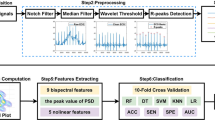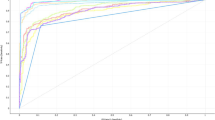Abstract
Hypertension is considered as a global public health problem by the World Health Organization. The risk of cardiovascular mortality grows with hypertension. The disease can be diagnosed by combined analysis of cardiac extracellular matrix (ECM) images and machine learning. This study proposes a novel method for automated classification of hypertension and its risk indexing using cardiac ECM images through machine learning. The method includes image pre-processing, Bi-dimensional Empirical Mode Decomposition (BEMD), feature extraction, feature selection, and classification guided by a statistical T-test for hypertension indexing. The proposed method applied over 300 cardiac ECM images and among them 150 belong to the normal group and the rest are from the hypertension group. The classification accuracy of the method is 98.9% with a sensitivity of 0.97 and specificity of 1. The F1 score, False Negative Rate, and False Positive Rate of the proposed method is 0.99, 0.02, and 0 respectively. Inspired by the classification accuracy, a unique Hypertension Risk Indexing (HRI) system has been developed focusing on minimum complexity of execution through prominent feature selection. Such an indexing mechanism can assist clinicians in the preliminary study of hypertension risk assessment.









Similar content being viewed by others
References
Lemarié CA, Tharaux P-L, Lehoux S (2010) Extracellular matrix alterations in hypertensive vascular remodeling. J Mol Cell Cardiol 48(3):433–439. https://doi.org/10.1016/j.yjmcc.2009.09.018
Aumailley M, Gayraud B (1998) Structure and biological activity of the extracellular matrix. J Mol Med 76(3):253–265. https://doi.org/10.1007/s001090050215
Bosman FT, Stamenkovic I (2003) Functional structure and composition of the extracellular matrix. The J Pathol A J Pathol Soc Great Britain Irel 200(4):423–428. https://doi.org/10.1002/path.1437
Streuli C (1999) Extracellular matrix remodelling and cellular differentiation. Curr Opin Cell Biol 11(5):634–640. https://doi.org/10.1016/S0955-0674(99)00026-5
Intengan HD, Schiffrin EL (2001) Vascular remodeling in hypertension: roles of apoptosis, inflammation, and fibrosis. Hypertension 38(3):581–587. https://doi.org/10.1161/hy09t1.096249
Skov K, Mulvany MJ (2004) Structure of renal afferent arterioles in the pathogenesis of hypertension. Acta Physiol Scand 181(4):397–405. https://doi.org/10.1111/j.1365-201X.2004.01311.x
López B, González A, Díez J (2004) Role of matrix metalloproteinases in hypertension-associated cardiac fibrosis. Curr Opin Nephrol Hypertens 13(2):197–204. https://doi.org/10.1097/01.mnh.0000119532.79618.fa
Frangogiannis NG (2017) The extracellular matrix in myocardial injury, repair, and remodeling. J Clin Invest 127(5):1600–1612. https://doi.org/10.1172/JCI87491
Schelbert EB et al (2014) Therapeutic targets in heart failure: refocusing on the myocardial interstitium. J Am Coll Cardiol 63(21):2188–2198. https://doi.org/10.1016/j.jacc.2014.01.068
Haas D, Hans J et al (2014) Molecular imaging of the cardiac extracellular matrix. Circ Res 114(5):903–915. https://doi.org/10.1161/CIRCRESAHA.113.302680
White SK et al (2012) Characterising the myocardial interstitial space: the clinical relevance of non-invasive imaging. Heart 98(10):773–779. https://doi.org/10.1136/heartjnl-2011-301515
Patnaik, R, et al. (2018) "Predicting the occurrence of essential hypertension using annual health records." 2018 Second International Conference on Advances in Electronics, Computers and Communications (ICAECC). IEEE, https://doi.org/10.1109/ICAECC.2018.8479458
Luo, Y, et al. (2018) "The prediction of hypertension based on convolution neural network." 2018 IEEE 4th International Conference on Computer and Communications (ICCC). IEEE, https://doi.org/10.1109/CompComm.2018.8780834
Fitriyani NL et al (2019) "development of disease prediction model based on ensemble learning approach for diabetes and hypertension." IEEE. Access 7:144777–144789. https://doi.org/10.1109/ACCESS.2019.2945129
Ren Y et al (2019) A hybrid neural network model for predicting kidney disease in hypertension patients based on electronic health records. BMC Med Inf Decis Making 19(2):131–138. https://doi.org/10.1186/s12911-019-0765-4
Tjahjadi H, Ramli K, Murfi H (2020) Noninvasive classification of blood pressure based on photoplethysmography signals using bidirectional long short-term memory and time-frequency analysis. IEEE Access 8:20735–20748. https://doi.org/10.1109/ACCESS.2020.2968967
Tjahjadi H, Ramli K (2020) Noninvasive blood pressure classification based on Photoplethysmography using K-nearest neighbors algorithm: a feasibility study. Information 11(2):93. https://doi.org/10.3390/info11020093
Rajput JS et al (2021) Automated detection of hypertension using wavelet transform and nonlinear techniques with ballistocardiogram signals. Inf Med Unlocked 26:100736. https://doi.org/10.1016/j.imu.2021.100736
Yang J et al (2022) Prediction of H-type hypertension based on pulse-taking and inquiry diagnosis. Biomed Signal Process Control 75:103573. https://doi.org/10.1016/j.bspc.2022.103573
Parmar KS, Kumar A, Kalita U (2022) ECG signal based automated hypertension detection using fourier decomposition method and cosine modulated filter banks. Biomed Signal Process Control 76:103629. https://doi.org/10.1016/j.bspc.2022.103629
Kandil H et al (2020) A novel computer-aided diagnosis system for the early detection of hypertension based on cerebrovascular alterations. NeuroImage: Clin 25:102107. https://doi.org/10.1016/j.nicl.2019.102107
Tuyet VTH, Binh NT (2021) Improving morphology and recurrent residual refinement network to classify hypertension in retinal vessel image. In: International conference on nature of computation and communication. Springer, Cham. https://doi.org/10.1007/978-3-030-92942-8_2
Xie, Y, et al. (2021) "Segmentation-based Retinal Image Fusion for Hypertension Prediction." 2021 the 7th International Conference on Communication and Information Processing (ICCIP). https://doi.org/10.1145/3507971.3507987.
Nunes JC, Guyot S, Deléchelle E (2005) Texture analysis based on local analysis of the bidimensional empirical mode decomposition. Mach Vis Appl 16(3):177–188. https://doi.org/10.1007/s00138-004-0170-5
Acharya UR et al (2017) Application of empirical mode decomposition (EMD) for automated identification of congestive heart failure using heart rate signals. Neural Comput & Applic 28(10):3073–3094. https://doi.org/10.1007/s00521-016-2612-1
Martis RJ et al (2012) Application of empirical mode decomposition (EMD) for automated detection of epilepsy using EEG signals. Int J Neural Syst 22(06):1250027. https://doi.org/10.1142/S012906571250027X
Maheshwari S, Pachori RB, Rajendra Acharya U (2016) Automated diagnosis of glaucoma using empirical wavelet transform and correntropy features extracted from fundus images. IEEE J Biomed Health Inf 21(3):803–813. https://doi.org/10.1109/JBHI.2016.2544961
Dong W et al (2014) A bidimensional empirical mode decomposition method for fusion of multispectral and panchromatic remote sensing images. Remote Sens 6(9):8446–8467. https://doi.org/10.3390/rs6098446
Mookiah MR, Krishnan et al (2015) Automated detection of age-related macular degeneration using empirical mode decomposition. Knowl-Based Syst 89:654–668. https://doi.org/10.1016/j.knosys.2015.09.012
Bhowmik MK et al (2017) Designing of ground-truth-annotated DBT-TU-JU breast thermogram database toward early abnormality prediction. IEEE J Biomed Health Inf 22(4):1238–1249. https://doi.org/10.1109/JBHI.2017.2740500
Haralick RM, Shanmugam K, Dinstein I’H (1973) Textural features for image classification. IEEE Trans Syst Man Cybern 6:610–621. https://doi.org/10.1109/TSMC.1973.4309314
Weszka JS, Dyer CR, Rosenfeld A (1976) A comparative study of texture measures for terrain classification. IEEE Trans Syst Man, Cybern 4:269–285. https://doi.org/10.1109/TSMC.1976.5408777
Amadasun M, King R (1989) Textural features corresponding to textural properties. IEEE Trans Syst Man, Cybern 19(5):1264–1274. https://doi.org/10.1109/21.44046
Wu C-M, Chen Y-C (1992) Statistical feature matrix for texture analysis. CVGIP: Graphic Model Image Process 54(5):407–419. https://doi.org/10.1016/1049-9652(92)90025-S
Laws KI (1979) Texture energy measures. In: Proc. Image understanding workshop. Sci. Appl., Los Angeles, pp 47–51
Wu C-M, Chen Y-C, Hsieh K-S (1992) Texture features for classification of ultrasonic liver images. IEEE Trans Med Imaging 11(2):141–152. https://doi.org/10.1109/42.141636
Banu, AKS, Ganesh SH (2015) "A study of feature selection approaches for classification." 2015 International Conference on Innovations in Information, Embedded and Communication Systems (ICIIECS). IEEE, https://doi.org/10.1109/ICIIECS.2015.7193259
Sun Y (2007) Iterative RELIEF for feature weighting: algorithms, theories, and applications. IEEE Trans Pattern Anal Mach Intell 29(6):1035–1051. https://doi.org/10.1109/tpami.2007.1093
Bardhan S et al (2018) "RASIT: region shrinking based accurate segmentation of inflammatory areas from Thermograms." biocybernetics and biomedical. Engineering 38(4):903–917. https://doi.org/10.1016/j.bbe.2018.07.002
Bardhan S, Bhowmik MK (2019) 2-stage classification of knee joint thermograms for rheumatoid arthritis prediction in subclinical inflammation. Australas Phys Eng Sci Med 42(1):259–277. https://doi.org/10.1007/s13246-019-00726-9
Bardhan, S, et al. (2020) "Designing of an inflammatory knee joint thermogram dataset for arthritis classification using deep convolution neural network." Quant InfraRed Thermography J : 1–27, https://doi.org/10.1080/17686733.2020.1855390.
Bardhan S, Roga S (2021) Feature based automated detection of COVID-19 from chest X-ray images. In: Emerging technologies during the era of COVID-19 pandemic. Springer, Cham, pp 115–131. https://doi.org/10.1007/978-3-030-67716-9_8
Bardhan S, Roga S (2021) Edge feature based classification of breast Thermogram for abnormality detection. In: Advances in mechanical engineering. Springer, Singapore, pp 511–517. https://doi.org/10.1007/978-981-15-3639-7_61
Bardhan S, Debnath S, Bhowmik MK (2018) Classification of IR image based inflammatory pain diseases using statistical pattern analysis approach. Int J Comput Intel IoT 1.2. https://ssrn.com/abstract=3354550. Accessed 06.09.2023
Bardhan, S, Nath S, Bhowmik MK (2017) "Evaluation of background subtraction effect on classification and segmentation of knee thermogram." 2017 8th International Conference on Computing, Communication and Networking Technologies (ICCCNT). IEEE https://doi.org/10.1109/ICCCNT.2017.8204011
Bhowmik, MK, et al. (2016) "Pain related inflammation analysis using infrared images." Thermosense: Thermal Infrared Applications XXXVIII. Vol. 9861. Int Soc Opt Photon, https://doi.org/10.1117/12.2223425
Bardhan, S, et al. (2015) "A review on inflammatory pain detection in human body through infrared image analysis." 2015 International symposium on advanced computing and communication (ISACC). IEEE, https://doi.org/10.1109/ISACC.2015.7377350
Roga S, Bardhan S, Lataye DH (2019) Air pollution monitoring using Blue Channel texture features of image. In: International conference on deep learning, artificial intelligence and robotics. Springer, Cham. https://doi.org/10.1007/978-3-030-67187-7_15
Sengar, P, Bardhan S. "Brain–Computer Interface: Review, Applications and Challenges." Mach Learn Deep Learn Med Data Anal Healthcare Appl: 23–38, https://doi.org/10.1201/9781003226147
Kumar T, Bardhan S (2021) Comparative analysis of edge detectors applying on the Noisy image using edge-preserving filter. In: International conference on advanced network technologies and intelligent computing. Springer, Cham. https://doi.org/10.1007/978-3-030-96040-7_29
Martinez-Ríos, E, Montesinos L, Alfaro-Ponce M (2022) "A machine learning approach for hypertension detection based on photoplethysmography and clinical data." Comput Biol Med : 105479, https://doi.org/10.1016/j.compbiomed.2022.105479
Acknowledgments
The authors would also like to thank Dr. M.K. Bhowmik, Assistant Professor, Department of Computer Science and Engineering, Tripura University, Suryamaninagar 799022, Tripura, India for his support during knowledge development in the area of image feature extraction and classification.
Author information
Authors and Affiliations
Corresponding author
Ethics declarations
Competing interests
The authors declare that they do not have any competing financial interests nor any personal relationships that could seem to have influenced the work presented by this paper.
Conflict of interest
Shawli Bardhan and Sukanta Roga declare that they have no conflict of interest.
Additional information
Publisher’s note
Springer Nature remains neutral with regard to jurisdictional claims in published maps and institutional affiliations.
Rights and permissions
Springer Nature or its licensor (e.g. a society or other partner) holds exclusive rights to this article under a publishing agreement with the author(s) or other rightsholder(s); author self-archiving of the accepted manuscript version of this article is solely governed by the terms of such publishing agreement and applicable law.
About this article
Cite this article
Bardhan, S., Roga, S. Hypertension detection and indexing from cardiac ECM image analysis. Multimed Tools Appl 83, 30541–30561 (2024). https://doi.org/10.1007/s11042-023-16746-3
Received:
Revised:
Accepted:
Published:
Issue Date:
DOI: https://doi.org/10.1007/s11042-023-16746-3




